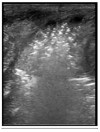Lung Ultrasound in the Neonatal Intensive Care Unit: Does It Impact Clinical Care?
- PMID: 34943297
- PMCID: PMC8700415
- DOI: 10.3390/children8121098
Lung Ultrasound in the Neonatal Intensive Care Unit: Does It Impact Clinical Care?
Abstract
A neonatal point-of-care ultrasound has multiple applications, but its use has been limited in neonatal intensive care units in the Unites States. An increasing body of evidence suggests that lung ultrasound performed by the neonatologist, at the bedside, is reliable and accurate in differentiating neonatal respiratory conditions, predicting morbidity, and guiding invasive interventions. Recent research has shown that a lung ultrasound can assist the clinician in accurately identifying and managing conditions such as respiratory distress syndrome, transient tachypnea of the newborn, and bronchopulmonary dysplasia. In this review, we discuss basic lung ultrasound terminology, evidence for applications of neonatal lung ultrasound, and its use as a diagnostic and predictive tool for common neonatal respiratory pathologies.
Keywords: lung ultrasound; neonatal respiratory pathologies; point-of-care ultrasound; respiratory failure.
Conflict of interest statement
The authors declare no conflict of interest.
Figures







References
Publication types
LinkOut - more resources
Full Text Sources

